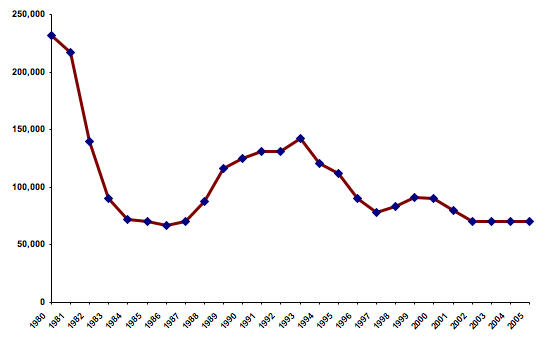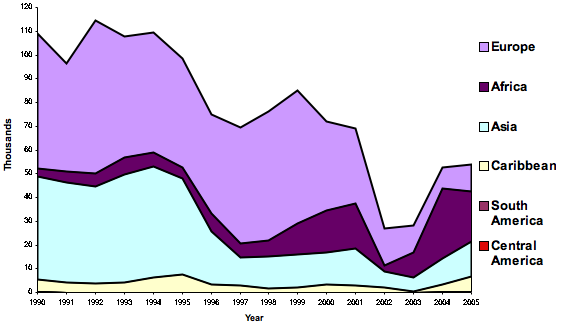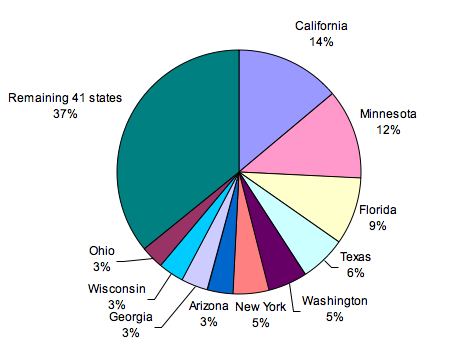Spotlight on Refugees and Asylees in the United States
Source Spotlights are often updated as new data become available. Please click here to find the most recent version of this Spotlight.
The refugee and asylum channel is one of three channels through which aliens can legally immigrate to the United States. The others are through employment and family creation/family reunification (see Spotlight on Legal Immigration to the United States).
This updated Spotlight closely examines the data on persons admitted to the United States as refugees or those granted asylum in 2005. It also provides the number of refugees and asylees receiving lawful permanent resident status (LPR) in 2005.
The data come from the 2005 Annual Flow Report on Refugees and Asylees and the 2005 Yearbook of Immigration Statistics, published by the Department of Homeland Security's Office of Immigration Statistics (OIS).
Note: all yearly data is for the government's fiscal year (October 1 through September 30). Unlike Annual Flow reports, previous OIS publications on refugees and asylees included information on the number of applications submitted, approved, and denied in addition to the number of persons admitted as refugees or granted asylum (see 2004 Yearbook of Immigration Statistics data tables).
Click on the bullet points below for more information:
Definitions
- Refugees and asylees are aliens who are unable or unwilling to return to their country of origin or nationality because of persecution or a well-founded fear of persecution.
- Aliens seeking asylum in the United States can submit an asylum request in one of two ways.
Refugee Data
- The annual ceiling for refugees admitted to the United States through the resettlement program has declined 70 percent in the last 26 years.
- More than 53,000 refugees were admitted to the United States through the resettlement program during 2005.
- Nationals of 10 countries accounted for 86 percent of all refugee arrivals in 2005.
- California, Minnesota, and Florida accounted for more than a third of all refugee resettlements.
Asylee Data
- More than 25,000 individuals (principals and their immediate family members) were granted asylum in 2005.
- China, Colombia, Haiti, and Venezuela accounted for half of all persons granted asylum in 2005.
Adjusting to Lawful Permanent Resident (LPR) Status Data
- More than 143,000 refugees and asylees adjusted their status to LPR in 2005.
- The number of refugees who adjusted their status to LPR nearly doubled, and the number of asylee adjustments nearly tripled, between 2004 and 2005.
Definitions
Refugees and asylees are aliens who are unable or unwilling to return to their country of origin or nationality because of persecution or a well-founded fear of persecution.
|
Refugees and asylees are similar in that they are aliens who are unable or unwilling to return to their country of origin or nationality because of persecution or a well-founded fear of persecution on account of race, religion, nationality, membership in a social group, or political opinion.
In the United States, the main difference between these two groups of people is the location of the person at the time of application — the refugees are generally outside of the United States when they are considered for resettlement, whereas asylum seekers submit their applications while they are physically present in the United States or at a port of entry.
Besides the definitional difference, refugees and asylees are different in the way they are treated by immigration and refugee law at the time of application, admission, and adjustment of their status to lawful permanent resident (LPR) status (see sidebar).
Aliens seeking asylum in the United States can submit an asylum request in one of two ways.
An asylum seeker present in the United States may submit an asylum request either with a United States Citizenship and Immigration Services (USCIS) asylum officer or, if apprehended, with an immigration judge as part of a removal hearing. If the case is denied, an applicant may appeal for additional hearings with the Board of Immigration Appeals or, in some cases, with federal courts.
Aliens may also request asylum at the port of entry. They are usually referred to the Asylum Officer Corps for "credible fear" interviews. The goal of such interviews is to determine whether asylum seekers are eligible to apply for asylum or for withholding of removal. If the Asylum Officer Corps determines the asylum seeker has a credible fear of return, the case is referred to an immigration judge.
Refugee Data
The annual ceiling for refugees admitted to the United States through the resettlement program has declined 70 percent in the last 26 years.
The admission ceiling for refugees has declined 70 percent, from 231,700 in 1980, when it was first introduced, to 70,000 in 2005 (see Figure 1).
There is a ceiling on refugee admission worldwide and by region. The president, in consultation with Congress, sets the ceilings at the beginning of each fiscal year. The ceilings are not quotas, meaning that the established limits do not have to be met (see Spotlight on the U.S. Refugee Program).
In 2005, the overall ceiling was 70,000, with the ceiling for Africa at 20,000, East Asia at 13,000, Europe at 9,500, Latin America and the Caribbean at 5,000, and the Near East and South Asia at 2,500; 20,000 were unallocated.
|
|
||
|
More than 53,000 refugees were admitted to the United States through the resettlement program during 2005.
In 2005, 53,813 individuals were admitted to the United States as refugees. This figure represented a two percent increase compared to the corresponding number in 2004 (52,868) and an 89 percent increase compared to the number in 2003 (28,422) (see Figure 2).
|
|
||
|
Nationals of 10 countries accounted for 86 percent of all refugee arrivals in 2005.
Altogether, nationals of the top 10 countries made up 85.9 percent of the 53,813 refugee arrivals in 2005 (see Table 1). These countries include Somalia, Laos, Cuba, Russia, Liberia, Ukraine, Sudan, Vietnam, Iran, and Ethiopia. Laos, Cuba, and Vietnam replaced three countries from the top-10 list in 2003: Serbia-Montenegro, Afghanistan, and Sierra Leone.
California, Minnesota, and Florida accounted for more than a third of all refugee resettlements.
In 2005, 34.7 percent (18,666) of all refugees were resettled in California, Minnesota, and Florida. Another 29.4 percent (15,811) were resettled in Texas, Washington, New York, Arizona, Georgia, Wisconsin, and Ohio (see Figure 3). Altogether, these 10 states accounted for more than two-thirds of all refugee arrivals.
|
|
||
|
Asylee Data
More than 25,000 individuals (principals and their immediate family members) were granted asylum in 2005.
The number of principals and their immediate family members who were granted asylum in 2005 was 25,257. This represented a seven percent decline compared to the corresponding number in 2004 (27,169) and a 12 percent decline compared to the number in 2003 (28,684).
Of the 25,257 asylees, 54 percent (13,520) were granted asylum affirmatively (ie, with a USCIS asylum officer) and 46 percent (11,737) were granted asylum defensively (ie, with an immigration judge as part of a removal hearing).
China, Colombia, Haiti, and Venezuela accounted for half of all persons granted asylum in 2005.
More than 5,000 nationals of the People’s Republic of China, 3,375 nationals of Colombia, 2,962 nationals of Haiti, and 1,114 nationals of Venezuela were granted asylum, accounting for 50.4 percent of all individuals who received asylum status in 2005 (see Table 2).
Adjusting to Lawful Permanent Resident (LPR) Status Data
More than 143,000 refugees and asylees adjusted their status to LPR in 2005.
Of the 142,962 refugees and asylees who adjusted their status to LPR in 2005, 112,676 (78.8 percent) were refugees and 30,286 (21.2 percent) were asylees. The number of refugees and asylees who adjusted their status to LPR has fluctuated greatly between 1994 and 2005 (see Figure 4).
|
|
||
|
The number of refugees who adjusted their status to LPR nearly doubled, and the number of asylee adjustments nearly tripled, between 2004 and 2005.
In 2004, only 61,013 refugees adjusted their status compared to 112,676 in 2005. The number of asylees who became LPRs in 2005 (30,286) nearly tripled compared to 10,217 in 2004, mostly thanks the REAL ID Act, which removed the 10,000-per-year limit on the number of asylees who could adjust to LPR status.
Additional Resources:
The Annual Flow Report on Refugees and Asylees: 2005. Available online.
The Yearbook of Immigration Statistics: 2005. Available online.
Definitions of terms can be found at the website of the Office of Immigration Statistics






